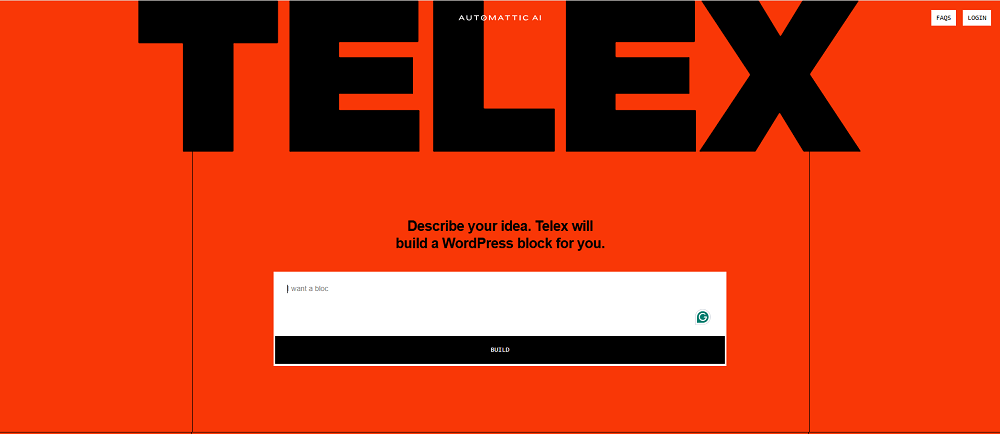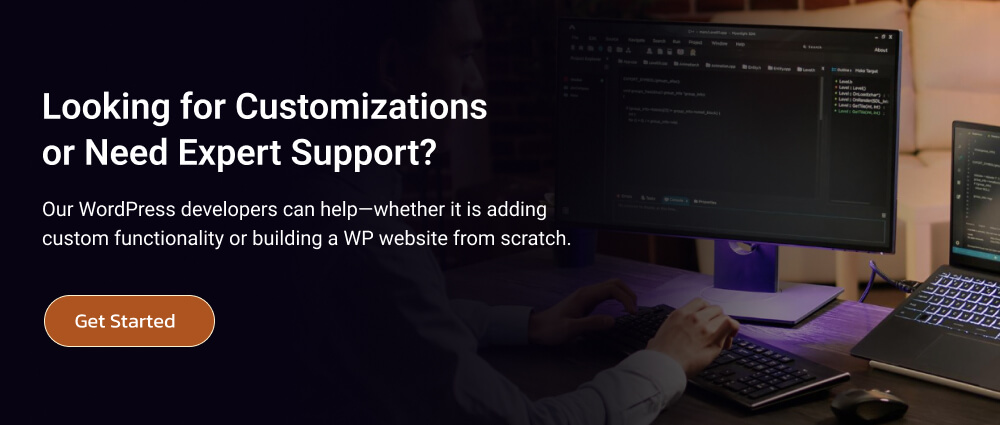
For years, WordPress has dominated the web‑development space, powering millions of sites globally with its flexibility and ease of use. However, as demand for faster and more efficient development grows, traditional workflows have begun facing limitations. They are often slow, resource-intensive, and show signs of strain as businesses require quicker turnaround times and intelligent features to retain customers. But thanks to AI and vibe coding, this is changing.
The former has emerged as a go-to solution for addressing inefficiencies, human errors, and redundancies in workflows. The same applies to WordPress development. With offerings like Elementor AI, Divi AI, and AISEO, as well as innovations like WordPress Telex, the WordPress community is streamlining and future-proofing the development process.
This blog aims to explore the current state of WordPress development, the impact of AI integration, and innovations such as Telex. Read on to discover how this presents new opportunities for both developers and businesses.
- WordPress Development: Exploring the Status Quo
- AI‑Powered Capabilities Within WordPress: A Closer Look
- What is WordPress Telex?
- Why Choose WordPress Telex for Faster Web Development?
- AI’s Current Limitations: Why is WordPress Telex Experimental
- WordPress Telex vs. Traditional WordPress Development: Which is Better
- What to Expect in the Future?
WordPress Development: Exploring the Status Quo
As user expectations grow and digital transformation accelerates, even a platform as versatile as WordPress is under pressure to evolve. This demand has revealed clear distinctions (and even increasing friction) between traditional vs. AI-integrated WordPress development.
Traditional WordPress Development: Characteristics and Friction Points
Traditional WordPress development has focused on hands-on workflows centered on technical expertise. Organizations often had internal web development teams or hired WordPress developers proficient in working with PHP, CSS, JavaScript, and MySQL, as well as WordPress themes, plugins, and Gutenberg blocks.
Key Characteristics of Traditional Web Development: Expert-led development with high control and scope of customization.
Inherent Friction Points:
- Time-Intensive Builds: Developing custom WordPress functionality, fine-tuning design elements, and ensuring cross-device compatibility can take weeks.
- Manual Maintenance: Continuous updates, plugin conflicts, and theme dependencies increase the burden on developers.
- Higher Development Costs: Tailored solutions require skilled resources, which drives up project budgets.
- Scalability Challenges: As websites expand, performance optimization and data handling become more resource-heavy.
AI-Integrated WordPress Development: Characteristics and Enhancements
AI-integrated WordPress development brings a new layer of efficiency to this process. Instead of replacing traditional methods, AI complements them by automating repetitive tasks, enhancing code quality, and accelerating development workflows.
Key Characteristics of AI-Assisted WordPress Development: Prompt-based WordPress development, where developers give instructions to generate significant portions of the boilerplate code or specific components.
Enhancements to the Process:
- Optimized WordPress Development Workflows: AI streamlines UI/UX design, SEO adjustments, and content generation, reducing the manual load on teams.
- Cost and Time Efficiency: By reducing development cycles and sometimes even the number of WordPress developers, AI tools help lower project costs while maintaining web standards.
- Continuous Learning: AI systems improve over time, offering more intelligent recommendations and pattern-based optimizations.
AI‑Powered Capabilities Within WordPress: A Closer Look
Let us take a closer look at notable AI features and tools currently transforming the WordPress ecosystem:
1. For Website Design and Prototyping
WordPress offers and is compatible with several AI-centric plugins, such as 10Web AI Website Builder and Elementor AI.
With 10Web AI Website Builder, developers can create holistic, mobile-friendly WordPress prototypes by automating the generation of complete layouts, content, and images. They can simply input business goals and design guidelines to complete the task within minutes.
Elementor AI, on the other hand, enables developers to generate wireframes for landing pages and custom design blocks. It can also interpret your input to create layouts as well as other visual elements and offer suggestions for content placement.
These AI-integrated WordPress plugins accelerate the design and iteration phase, ultimately reducing time-to-market.
2. For WordPress Theming
Theming is one of the most essential front-end aspects of WordPress development as it determines the overall look and feel of your site. AI-integrated WordPress tools in this area automate theme creation and customization, making it easier to achieve professional, brand-aligned designs quickly and efficiently.
The Divi AI plugin is a good example. Built for the WordPress ecosystem and compatible within the Divi theme, it enables designers and developers to add custom CSS elements to their websites.
SeedProd is another plugin that enables AI‑driven theme building. Developers can create custom header/footer sections, hero sections, CTAs, etc.
3. For Core WordPress Development
WordPress also comes with several AI integrations, such as the AI Engine Plugin and the recently launched Telex, that simplify core development tasks.
The AI Engine Plugin integrates WordPress with OpenAI’s models, allowing developers to generate custom code for features such as forms, chatbots, and complex integrations based on simple natural language inputs.
WordPress Telex is an experimental AI tool that generates custom Gutenberg blocks based on natural language inputs. Developers can describe the type of block they need (e.g., a testimonial carousel or a pricing table), and Telex automatically generates the necessary code.
We’ll explore WordPress Telex in greater detail.
What is WordPress Telex?
In September 2025, WordPress introduced an early version of an AI-integrated development tool, Telex, at the WordCamp US Conference in Portland. As per CEO Matt Mullenweg, “Telex is like V0 or Lovable, but specifically for WordPress.” The idea was to highlight the famous ‘vibe coding’ aspect, wherein developers can build software using prompts.

It is available at its own domain – telex.automattic.ai. This launch comes about a year after WordPress announced its investment in an AI team to future-proof the ecosystem and steward AI product development, aligning with the platform’s goals.
Why Choose WordPress Telex for Faster Web Development?
Telex allows users to enter a natural-language prompt describing the feature they want (e.g., “a testimonial carousel with fade‑in effect”) and automatically generates a working Gutenberg block, packaged as a downloadable plugin (.zip), that can be installed on a WordPress site.
From a practical standpoint, WordPress Telex opens doors to faster prototyping, reduced manual scaffolding, and new creative workflows for both developers and enterprises.
WordPress Telex Benefits: Speed, Efficiency, and Quality
Telex promises the following benefits:
1. Faster Time-to-Market
Creating custom Gutenberg blocks is a fundamental part of modern WordPress development. These reusable components serve as the building blocks of future pages and sites. According to industry data, custom block or plugin development can take anywhere from 40 to 300+ hours, depending on the complexity.
WordPress Telex’s speed and performance capabilities accelerate this phase by automating block creation, significantly reducing the time (down to a few minutes) and resource investment required.
2. WordPress-Centric Optimization
The blocks generated by Telex adhere to WordPress coding standards, ensuring better performance and compatibility. This helps avoid performance issues and plugin conflicts that can arise with manually coded components.
3. Easier Prototyping
With WordPress Telex, developers can quickly generate basic site components for client approval, then fine-tune the generated code to fit specific requirements. This reduces the back-and-forth usually required in the design and development stages.
4. Better Site Maintainability
Since the generated blocks follow WordPress conventions, they are easier to maintain and update compared to manually written custom code, especially for future compatibility with WordPress core updates.
WordPress Telex Pricing: Development Benefits
Currently, Telex is offered in an experimental phase by Automattic—meaning there’s no cost for trying its AI features. The primary benefit isn’t just in licensing cost—it’s in the reduction of development hours.
| Cost Component | Typical Traditional WordPress Cost | How WordPress Telex Reduces the Cost |
|---|---|---|
| Custom Block Coding (Dev Hours) | Traditional WordPress development requires 20-100+ hours of developer time, depending on complexity and the tech stack (e.g., JavaScript, PHP). | Telex removes much of the manual code writing — potentially reducing hours by up to 50‑70% in many scenarios. |
| Scaffolding & Reuse Effort | WordPress developers recreate similar components (such as carousels, testimonials, and pricing tables) across multiple projects, incurring incremental costs. | WordPress Telex generates reusable block templates, reducing duplication of effort, enabling quicker reuse, and lowering incremental build cost per component. |
| Testing & QA of Manually Coded Blocks | Manually coded blocks require expert QA, cross-browser testing, plugin conflict testing, and performance tuning — all of which incur additional costs. | As Telex outputs standardized code aligned with WordPress norms, less hand‑tuning may be required. Fewer bugs/conflicts = lower QA and maintenance cost. |
| Opportunity Cost | Longer WordPress development cycles delay go‑live, increasing client cost (and delay in revenue from site launch). | Telex speeds up block/component creation, allowing sites or features to go live faster — reducing both direct costs and indirect opportunity costs of delay. |
| Maintenance & Upgrades | Custom-coded blocks may not adhere to best practices or may require additional future maintenance, thereby increasing long-term maintenance costs. | Blocks generated via Telex are likely to adhere to standard WordPress architecture (when properly reviewed), so maintenance overhead is reduced, resulting in lower cost over time. |
WordPress Telex Use Cases and ROI
Telex is designed to streamline WordPress development. Below are some of the key business-specific use cases of Telex:
- For Agencies: WordPress Telex streamlines the management of multiple client projects, enabling agencies to deliver projects faster without compromising customization. This increases the number of clients served and improves profitability.
- For Enterprises: Businesses with complex WordPress sites or multi‑site networks benefit from WordPress Telex by simultaneously automating block generation across different departments or regions. Once initial development is complete, local teams can customize the solution based on their unique needs. This reduces redundancies while centralizing development.
- For Freelancers: Freelance web developers can use exact client instructions as preliminary prompts to generate hyper-personalized Gutenberg blocks with WordPress Telex, thereby reducing the time spent on experimentation. This allows them to deliver high-quality work and increases their capacity to take on more projects.
- For Web Development Teams: Teams working on large projects can use WordPress Telex to accelerate the prototyping and testing phases. They can quickly create multiple website versions, test them with clients, and then refine the output as needed.
AI’s Current Limitations: Why is WordPress Telex Experimental
While WordPress Telex offers significant advantages in terms of speed, efficiency, and cost-effectiveness, it’s essential to recognize that it’s still in the experimental phase. As with any emerging technology, AI‑powered WordPress development tools have their limitations that need to be carefully considered before widespread adoption. Let’s see why it is still experimental:
1. Limited Scope of Customization for Complex Features
Telex can easily generate simple blocks from basic language prompts, but it struggles to add complex functionality that requires some business logic or multi-step integrations. You will need to delve deeper into prompting and reworking the block, thereby defeating its core purpose: time savings.
2. Inconsistent Quality of AI-Generated Blocks
The quality of the output is highly dependent on the quality of the input. While Telex is suitable for generating standard blocks, the generated code may not always meet performance, security, or accessibility standards without additional manual review.
3. Limited Support for Full Site Generation
WordPress Telex focuses primarily on block generation (Gutenberg blocks), but it doesn’t yet offer comprehensive support for building full websites. It doesn’t automatically cater to broader site elements, such as dynamic headers, footers, or advanced theme customizations—they are to be added manually.
4. Learning Curve
Telex is an AI-driven WordPress development tool. While the interface is designed to be user‑friendly, there’s still a learning curve in understanding how to use the tool for optimal results.
5. Dependency on Pre-Defined Templates and Blocks
WordPress Telex is built around pre-defined blocks and templates, which limit its flexibility in innovating and creating unconventional components. As a result, creativity takes a hit (at least currently).
6. Potential Performance Overheads
AI‑generated code may not be as optimized as manual code. In some cases, the generated blocks may introduce performance issues, such as bloated code or unnecessary scripts, that could slow down page load times or conflict with other site elements.
As a result, WordPress developers still need to intervene, add customizations, do thorough QA, and maintain constant oversight.

WordPress Telex vs. Traditional WordPress Development: Which is Better
| Aspect | Traditional WordPress Development | AI-Assisted WordPress Development |
|---|---|---|
| WordPress Telex vs. Traditional Development in Terms of Speed | Slower due to manual coding and custom development | Faster block/component creation through AI prompts |
| WordPress Telex vs. Traditional Development in Terms of Customization | Fully customizable based on unique requirements | Limited to predefined templates, requires human refinement |
| WordPress Telex vs. Traditional Development in Terms of Code Quality | Custom, flexible, but prone to human error | Standardized, but may require refinement for complex features |
| WordPress Telex vs. Traditional Development in Terms of Cost | Higher due to manual coding, testing, and debugging | Lower due to reduced development hours |
| WordPress Telex vs. Traditional Development in Terms of Complexity Handling | Ideal for complex, business-specific functionality | Best for simple to moderately complex blocks |
| WordPress Telex vs. Traditional Development in Terms of Performance Optimization | Full control over performance optimization | May require manual review to ensure performance and compatibility |
| WordPress Telex vs. Traditional Development in Terms of Maintenance | More maintenance is required due to custom solutions | Easier for standard blocks, may need refinements over time |
| WordPress Telex vs. Traditional Development in Terms of Flexibility | High flexibility, ideal for unique, creative designs | Limited to what AI tools can generate |
What to Expect in the Future?
As AI continues to reshape WordPress development (and web development, in general), tools like Telex are proving to be valuable accelerators for specific workflows. Although it is still in an experimental phase, Telex represents a monumental achievement that makes WordPress a forward-compatible web development platform.
However, given Telex’s current limitations, it’s clear that AI tools still need to evolve to handle more complex and customized projects. This realization also comes with the understanding that, despite AI advancements, human oversight remains irreplaceable. AI-integrated WordPress development tools may automate coding, prototyping, and other tasks, but they cannot implement complex business logic and user-centric functionalities as effectively as experts.
For businesses, staying ahead in such a scenario means embracing AI innovations while reskilling your WordPress development teams to maximize their potential. If this seems like a stretch at the moment, you can also outsource professional WordPress development services and work with experts who are proficient in using such tools.
